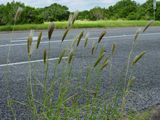Native Plants

Q. Who is Mr. Smarty Plants?
A: There are those who suspect Wildflower Center volunteers are the culpable and capable culprits. Yet, others think staff members play some, albeit small, role. You can torture us with your plant questions, but we will never reveal the Green Guru's secret identity.
Did you know you can access the Native Plant Information Network with your web-enabled smartphone?
Ask Mr. Smarty Plants is a free service provided by the staff and volunteers at the Lady Bird Johnson Wildflower Center.

rate this answer
Thursday - May 16, 2013
From: Lake Jackson, TX
Region: Southwest
Topic: Non-Natives, Grasses or Grass-like
Title: Native alternative to Japanese grass from Lake Jackson TX
Answered by: Barbara Medford
QUESTION:
Is there a native alternative to Little Kitten maiden grass? I was asked to comment on a plan and don't want them to introduce another Japanese plant into our local habitat.ANSWER:
Before we could answer your question we first had to determine what the non-native grass is to which you refer. Turns out it is Miscanthus sinensis 'Little Kitten' which is, indeed, native to eastern Asia. It is a member of the Poaceae (grass) family, and is referred to as a "blooming grass." What it is not, as you have already pointed out, is native to South Texas, in the area of Brazoria County.
Since the Lady Bird Johnson Wildflower Center, home of Mr. Smarty Plants, is committed to the growth, propagation and protection of plants native not only to North America but to the area in which those plants grow naturally, we are anxious to find some natives for you to propose as alternatives. These are all members of the Poaceae family and grow in or near Brazoria County. You can follow each plant link to our webpage on that plant to learn its expected mature size, growing conditions, water needs, preferred soil, etc. Since they are native to your area, they are much more likely to do well in your climate, soils and rainfall than grasses from Asia.
Chloris virgata (Feather fingergrass) - 0 - 1 ft. tall
Heteropogon contortus (Tanglehead) - 0 - 1 ft. tall
Andropogon gerardii (Big bluestem) - 3 to 6 ft. tall
Schizachyrium scoparium (Little bluestem) - 3 to 6 ft. tall
From the Image Gallery
More Non-Natives Questions
Different kinds of lantana in Wilmington, NC
July 19, 2009 - I live in Wilmington, NC. I spent a small fortune on three varieties of lantana--Cherry Sunrise, Ham & Eggs and Bandana Red.
I live on a salt water tidal creek and most are in full sun. Some are i...
view the full question and answer
Dry, brown leaves on non-native weeping willow
August 03, 2008 - Hello! I live in Pennsylvania I have 5 weeping willows I planted 3 years ago. All seemed well until last week I noticed suddenly one looks like it might be dying!? All the leaves are dry & brown. T...
view the full question and answer
Identification of non-native Nothoscordum borbonicum in Louisiana
March 26, 2006 - There were some small white flowers that grow everywhere in Shreveport and probably elsewhere. Mother called them Crows Feet. I see them if I am home in the Springtime, smell them too. Is Crow's foot...
view the full question and answer
Fruit trees for Buckeye AZ
May 16, 2010 - I am moving to Buckeye Az from Utah and would like to know what type of fruit trees I can grow.
Thanks!
view the full question and answer
Non-native Japanese maple seedling in Rotterdam NY
August 09, 2010 - In the first couple days of August, I discovered a baby Japanese Maple growing against the wall of my storage shed, a short distance from a neighbor's full grown Japanese Maple. I transplanted this 5...
view the full question and answer
| Support the Wildflower Center by Donating Online or Becoming a Member today. |

